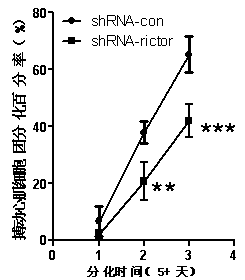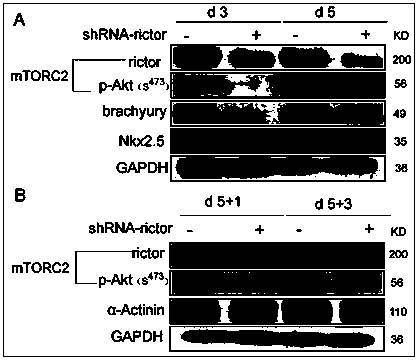Pharmaceutical application of Rictor/mTORC2 in heart development and disease treatment
A technology of cardiomyocytes and stem cells, applied in the field of drug use of Rictor/mTORC2 in cardiac development and disease treatment
- Summary
- Abstract
- Description
- Claims
- Application Information
AI Technical Summary
Problems solved by technology
Method used
Image
Examples
Embodiment 1
[0017] Example 1 Effect of ES-D3 cells interfering with rictor on directional cardiomyocyte differentiation
[0018] 1. Interfering rictor gene in ES-D3 cells by lentiviral shRNA
[0019] Mouse ES-D3 cells were used, shRNA-rictor was added for transfection, and a control group was set. The shRNA-rictor interference sequence is as follows: 5'-CCGGGCCAGTAAGATGGGAATCATTCTCGAGAATGATTCCCATCTTACTGGCTTTTTG-3'; On the day of transfection, aspirate the cell supernatant, add the virus stock solution to the culture bottle according to the MOI value of 10 PFU / cell, and add normal culture solution to 2 ml, gently shake the Petri dish while adding to ensure even distribution and avoid local high concentration. Put the cells back into the incubator and incubate at 37°C for 72-96 h, then observe the fluorescence expression. The transfection efficiency is about 80%, and the cell differentiation experiment is carried out according to the hanging drop-suspension-attachment culture method. ...
Embodiment 2
[0026] Example 2 Western blot was used to detect the effect of ES-D3 cells interfering with rictor on the expression of myocardial specific proteins during cardiomyocyte differentiation.
[0027]The EB and cardiomyocyte clusters differentiated on d 3, d 5, d 5+1 and d 5+3 were collected to investigate the expression of related proteins. The protein was added to 5×SDS buffer, denatured by boiling for 5 min, and electrophoresed in a 10 % SDS-polyacrylamide gel for about 2 h; then the protein was transferred to a PVDF membrane with an electrotransfer apparatus for about 1.5 h; 5% skimmed milk was dissolved in room temperature for blocking for 1 h, rinsed with T-PBS (0.05% Tween) for 3 times (15 min, 5 min, 5 min); add goat anti-rictor (1:1000), rabbit anti-p-Akt (1 :1000), rabbit anti-p-Akt (1:1000), rabbit anti-brachyury (1:1000), rabbit anti-Nkx2.5, (1:1000), mouse anti-α-Actinin (1:1000), mouse anti-GAPDH (1:10000), incubate overnight at 4°C, rinse with T-PBS 3 times (15 mi...
Embodiment 3
[0029] Example 3: Quantitative detection of the effect of ES-D3 cells interfering with rictor on the number of cardiomyocytes by flow cytometry.
[0030] Collect ES-D3 cell-derived cardiomyocyte samples adherently differentiated for 3 days, digest into single cells with collagenase II, fix with 1% paraformaldehyde for 1 h, and then block with 3% BSA for 1 h, and apply primary antibody: cardiomyocytes Cell-specific protein Monoclonal mouse anti-α-Actinin, diluted 1:500, incubated overnight at 4°C. The next day, add the secondary antibody: Dylight549-Conjugatedgoat anti-mouse IgG, diluted 1:500, and incubate at 37°C for 1.5 h. On-board testing.
[0031] See results image 3 . The results showed that the number of cardiomyocytes significantly decreased after ES-D3 cells interfered with rictor. The number of cardiomyocytes in the interference rictor group was 5.8±1.7%, which was significantly reduced compared with 12.5±1.1% in the negative control group (** P <0.01).
PUM
 Login to View More
Login to View More Abstract
Description
Claims
Application Information
 Login to View More
Login to View More - R&D
- Intellectual Property
- Life Sciences
- Materials
- Tech Scout
- Unparalleled Data Quality
- Higher Quality Content
- 60% Fewer Hallucinations
Browse by: Latest US Patents, China's latest patents, Technical Efficacy Thesaurus, Application Domain, Technology Topic, Popular Technical Reports.
© 2025 PatSnap. All rights reserved.Legal|Privacy policy|Modern Slavery Act Transparency Statement|Sitemap|About US| Contact US: help@patsnap.com



